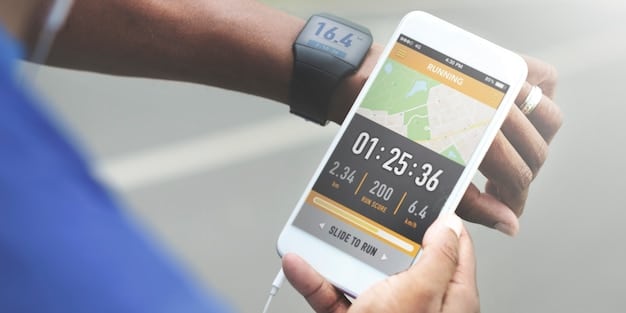Break Free: 5 Steps to Overcome Phone Addiction

Practical Solutions: 5 Steps to Break Your Phone Addiction and Reclaim Your Life offers actionable strategies to reduce screen time, fostering healthier habits and promoting overall well-being.
In today’s digital age, it’s easy to find ourselves glued to our phones, losing precious time and attention. If you’re struggling with excessive phone use, know that you’re not alone. This guide offers practical solutions: 5 steps to break your phone addiction and reclaim your life, helping you regain control and find a healthier balance.
Understand Your Phone Usage
The first step towards breaking any addiction is understanding it. Before you can implement solutions, it’s essential to honestly assess your relationship with your phone.
Track Your Time
Start by tracking how much time you actually spend on your phone. Both iOS and Android devices have built-in features that show you your screen time. There are also numerous apps available that can provide even more detailed insights.
Pay attention to when and why you reach for your phone. Are you bored, stressed, or just habitually checking notifications?
- Use built-in screen time trackers on your phone.
- Explore third-party apps for more detailed analytics.
- Note the times of day you use your phone the most.
Understanding your usage patterns will help you identify triggers and problem areas.

Identify Your Triggers
What situations or emotions lead you to pick up your phone? Identifying these triggers is crucial for developing effective coping mechanisms.
Common triggers include boredom, loneliness, stress, and even social pressure to stay connected. Once you know what prompts your phone use, you can start to develop alternative behaviors.
- Keep a journal to log your feelings and situations before picking up your phone.
- Notice patterns in your phone usage related to specific emotions or activities.
- Ask yourself “Why am I reaching for my phone right now?”
By pinpointing your triggers, you gain the power to consciously choose a different response.
In conclusion, understanding your phone usage patterns and identifying your personal triggers is the foundation for breaking free from phone addiction. Once you have this awareness, you can begin to implement targeted strategies to reduce your screen time and reclaim your attention.
Set Realistic Goals and Limits
Once you understand your phone usage, the next step is to set realistic goals and limits for yourself. Going cold turkey rarely works; gradual changes are more sustainable.
Start Small
Don’t try to drastically cut your screen time overnight. Instead, start with small, achievable goals. For example, aim to reduce your daily phone usage by 15-30 minutes each week.
Celebrate your progress along the way. Every small victory will motivate you to keep going.
Use App Timers
Most smartphones allow you to set daily time limits for specific apps. Use this feature to control your usage of apps that you know are particularly addictive, such as social media platforms.
- Set daily time limits for social media apps.
- Utilize website blockers on your computer to reduce access to distracting sites.
- Consider apps that lock you out of your phone entirely for set periods.
App timers provide a tangible way to hold yourself accountable and stay within your self-imposed limits.
Another tactic is to schedule specific “phone-free” times each day. This could be during meals, before bed, or during your commute. Create designated times to disconnect and engage in other activities.
Setting realistic goals and step-by-step limits is a way to ease yourself back into life apart from your phone. Small adjustments in habits can mean a large adjustment in your overall well being.
Create Phone-Free Zones and Times
Establishing designated phone-free zones and times in your daily life can significantly reduce your dependence on your device.
Designate Physical Spaces
Make certain areas of your home phone-free zones. Your bedroom, dining table, and workspace are great candidates. This allows you to create a sanctuary where you can focus on other activities and interactions.
By consciously excluding your phone from these spaces, you create a physical separation that promotes mindfulness and reduces temptation.
Schedule Digital Detoxes
Plan regular digital detox periods, whether it’s for a few hours each day or a full weekend. During these times, put your phone away and engage in activities that don’t involve screens.
Use this time to reconnect with nature, spend time with loved ones, pursue hobbies, or simply relax and unwind.
- Leave your phone in another room while you eat dinner.
- Declare your bedroom a phone-free zone.
- Establish periods of digital detox on the weekends.
These conscious and pre-planned detachments can drastically alter the role your phone plays in your day to day life.

Phone-free zones and designated digital detoxes can provide a necessary antidote to constant digital stimulation. By creating space for mindful engagement and real-world experiences, you actively combat phone addiction and reclaim your time.
Find Replacements and Healthy Habits
One of the biggest challenges in breaking phone addiction is filling the void left behind when you reduce your screen time. Finding fulfilling replacements and developing healthy habits is key to lasting change.
Rediscover Hobbies
Think back to activities you used to enjoy before your phone became a constant companion. Rediscover old hobbies or explore new ones that spark your interest.
This could be anything from reading and writing to painting, playing a musical instrument, or engaging in sports.
Filling your time and your mind with creative fulfillment can be more enticing than the glow from your phone.
Connect with Others
Make an effort to connect with friends and family in person. Meaningful social interactions can provide a sense of belonging and reduce feelings of loneliness that often trigger phone use.
- Join a club or sports team.
- Volunteer in your community.
- Schedule regular coffee dates with friends.
Real-life relationships are essential for mental and emotional well-being.
Finding alternatives to phone use, like engaging hobbies, and socializing can make the transition away from your phone more enjoyable. It’s as easy as finding something that enriches your life more than your phone does.
Seek Support and Accountability
Breaking phone addiction can be a challenging process, and it’s important to seek support and accountability along the way.
Talk to Someone
Share your struggles with a trusted friend, family member, or therapist. Talking about your addiction can help you gain perspective and feel less alone.
Find an Accountability Partner
Enlist a friend or family member to be your accountability partner. Check in with them regularly to discuss your progress, setbacks, and strategies for staying on track.
- Join an online support group.
- Find an accountability partner.
- Consider professional counseling or therapy.
Having someone who understands and supports your goals can make a significant difference.
Addiction can make you feel like you are lost at sea with no land in sight. Having support during times like this when you are most vulnerable can be the difference between continuing and stopping. Find your community and find a place to share your success and struggles with this obstacle in your life.
| Key Action | Brief Description |
|---|---|
| 📱 Monitor Usage | Track daily screen time to understand your habits. |
| 🎯 Set Limits | Gradually reduce screen time and use app timers. |
| 📴 Create Zones | Designate phone-free areas and times to disconnect. |
| 🏞️ Find Alternatives | Engage in hobbies and socialize offline. |
Frequently Asked Questions (FAQ)
▼
If you consistently exceed your intended screen time, feel anxious without your phone, or prioritize it over real-life responsibilities, you may be experiencing phone addiction.
▼
Breaking phone addiction can improve your focus, sleep quality, relationships, and overall mental well-being by promoting more mindful engagement with the world around you.
▼
Set specific times for checking work-related communications and designate a trusted contact for emergencies, ensuring you’re accessible without constant phone engagement.
▼
Yes, apps like Forest, Offtime, and Freedom can help you track your phone usage, set time limits, and block distracting apps, providing tools for managing your screen time.
▼
The timeline varies depending on the severity of your addiction and your commitment to change. Some may see results in weeks, while others may require months of consistent effort.
Conclusion
Breaking free from phone addiction is a journey that requires awareness, commitment, and self-compassion. By understanding your usage, setting realistic goals, creating phone-free zones, finding fulfilling replacements, and seeking support, you can reclaim your time, attention, and ultimately, your life.





